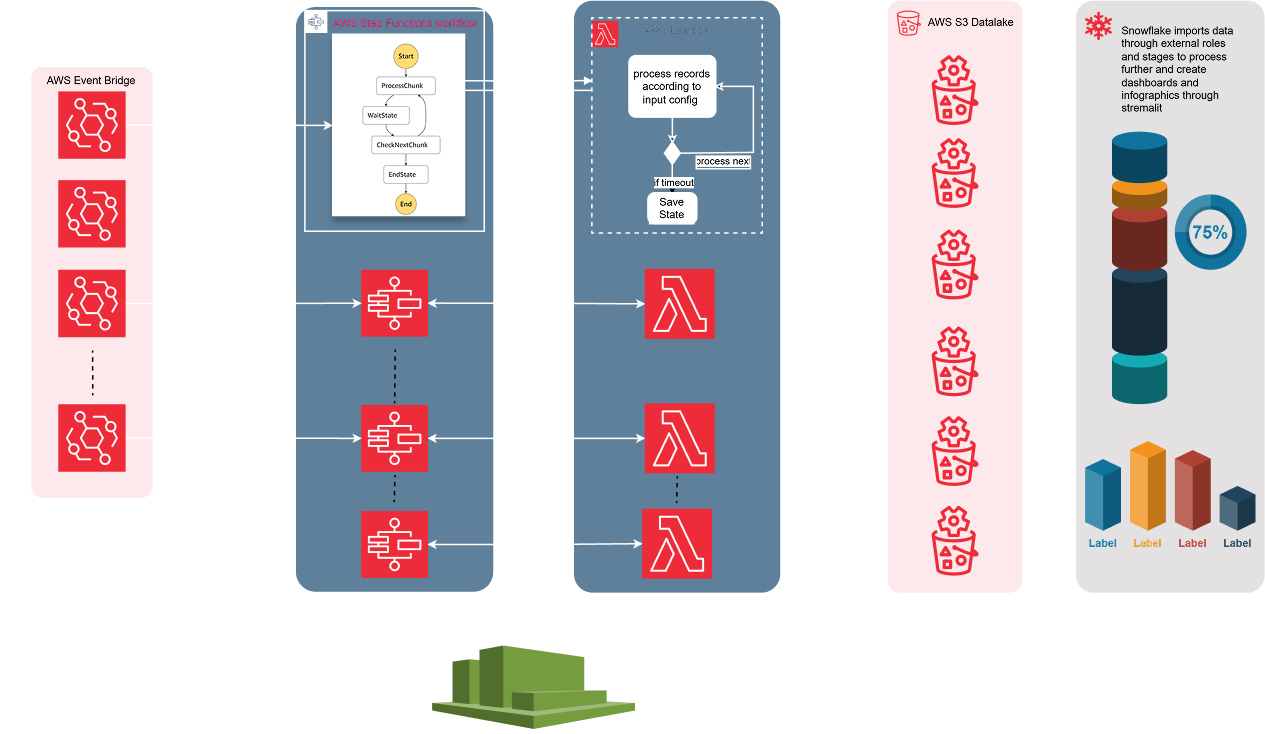How we transformed a sequential bottleneck into a scalable, real-time analytics solution processing data from thousands of restaurant locations across the USA.
A client aiming to conduct market analysis for their product positioning needed a highly scalable and automated data lake solution to collect, process, and integrate menu data from thousands of restaurant locations across the USA. The primary goal was to enable real-time data acquisition, transformation, and visualization for business insights.
Gather menu data from thousands of restaurants
Transform data in near real-time
Build a system that can recover from failures
The client had invested heavily in a custom-coded solution to gather restaurant menu data, believing it would be the key to unlocking powerful insights. However, what started as a promising initiative quickly turned into a daily struggle.
Their system operated in a sequential, time-consuming manner, leading to frustrating delays in data availability. The data ingestion process, initially manageable, became an overwhelming bottleneck as the number of restaurants grew.
To make matters worse, time zones wreaked havoc on automation — the system failed to align with the local serving hours of restaurants. Breakfast, lunch, and dinner menus appeared at different times, but the rigid workflow missed crucial data or captured the wrong menu items.
It was clear: the system wasn’t scalable, wasn’t efficient, and wasn’t sustainable.
The client faced multiple challenges in building a reliable data lake for restaurant analytics:
Thousands of restaurant locations required real-time ingestion.
Different restaurants had unique menu structures, making standardization difficult.
The system needed to scale dynamically while ensuring resilience against failures.
Traditional methods took days, making real-time analysis impossible.
Different menus (breakfast, lunch, dinner) were presented at different time periods.
Due to multiple time zones in the USA, exact menu-serving time periods needed to be accounted for.
The system needed to ensure minimal impact on the host websites to prevent disruption to normal traffic.
To address these challenges, we built a serverless, event-driven data lake architecture leveraging AWS cloud services. Our solution focused on scalability, reliability, and efficiency.

Instead of using a single ingestion process, the solution executes parallel data lake ingestion tasks using AWS Lambda.
AWS EventBridge triggers ingestion jobs at scheduled intervals, while AWS Step Functions orchestrate execution, retries, and dependencies.
Raw ingested data is processed, cleaned, and standardized using AWS Glue before being stored in a structured format within the data lake.
Processed data is stored in Snowflake, a cloud-based data warehouse, allowing efficient query execution and analytics.
AWS Lambda executes multiple ingestion jobs simultaneously, significantly reducing execution time.
Step Functions manage retries and prevent cascading failures.
AWS Glue optimizes data transformation workflows for better performance.
Ensuring menu data ingestion aligns with local time zones for accurate meal categorization.
Implementing delays and request throttling to avoid overloading host websites.
Our solution transformed the client's data acquisition capabilities, delivering significant improvements in performance, reliability, and business value.
Data ingestion that previously took days is now completed in hours.
The system dynamically scales based on demand and withstands failures gracefully.
Businesses can access the latest menu data for data- driven decision-making.
Automation eliminated manual interventions, streamlining the data ingestion process.
AWS's pay-as-you-go model significantly reduced infrastructure costs.
Accurate and up-to-date menu data improved competitive analysis and market positioning.
By leveraging AWS Lambda, EventBridge, Step Functions, AWS Glue, and Snowflake, we built a scalable, fault- tolerant, and cost-efficient data lake solution. This system successfully transformed the client's data acquisition pipeline, enabling real-time insights at scale.
Using ML models to detect anomalies in menu data.
With AWS CloudWatch to proactively detect and resolve issues.
With AWS AI/ML Services to generate deeper business insights.
"This case study demonstrates how cloud-native, serverless architectures can revolutionize large-scale data lake building, making it faster, cost-effective, and more reliable."